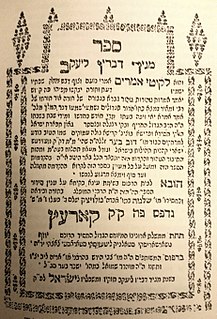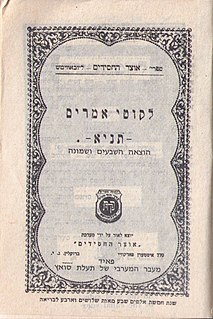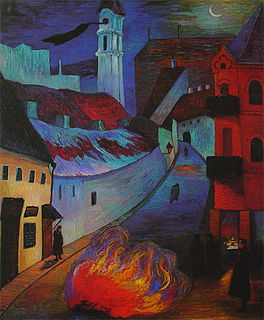The Sabbateans were a variety of followers of disciples and believers in Sabbatai Zevi (1626–1676), a Jewish rabbi who was proclaimed to be the Jewish Messiah in 1666 by Nathan of Gaza. Vast numbers of Jews in the Jewish diaspora accepted his claims, even after he became a Jewish apostate with his conversion to Islam in the same year. Sabbatai Zevi's followers, both during his "Messiahship" and after his conversion to Islam, are known as Sabbateans. They can be divided into three groups: Maaminim (believers), Haberim (associates), and Ba'ale Milhamah (warriors).

Shneur Zalman of Liadi, was an Orthodox rabbi and the founder and first Rebbe of Chabad, a branch of Hasidic Judaism, then based in Liadi in the Russian Empire. He was the author of many works, and is best known for Shulchan Aruch HaRav, Tanya, and his Siddur Torah Or compiled according to the Nusach Ari. Zalman is a Yiddish variant of Solomon and Shneur is a Yiddish composite of the two Hebrew words "shnei ohr".

Dov Ber ben Avraham of Mezeritch, also known as the Maggid of Mezritch, was a disciple of Rabbi Yisrael Baal Shem Tov, the founder of Hasidic Judaism, and was chosen as his successor to lead the early movement. Dov Ber is regarded as the first systematic exponent of the mystical philosophy underlying the teachings of the Baal Shem Tov, and through his teaching and leadership, the main architect of the movement. He established his base in Mezhirichi, which moved the centre of Hasidism from the Baal Shem Tov's Medzhybizh, where he focused his attention on raising a close circle of great disciples to spread the movement. After his death, avoiding the unified leadership of the first two generations, this third generation of leadership took their different interpretations and disseminated across appointed regions of Eastern Europe. Under the inspiration of their teacher, this rapidly spread Hasidism beyond Ukraine, to Poland, Galicia and Russia.

The Tanya is an early work of Hasidic philosophy, by Rabbi Shneur Zalman of Liadi, the founder of Chabad Hasidism, first published in 1797. Its formal title is Likkutei Amarim, but is more commonly known by its opening word, Tanya, which means "it was taught in a beraita". It is composed of five sections that define Hasidic mystical psychology and theology as a handbook for daily spiritual life in Jewish observance.

Medzhybizh, previously known as Mezhybozhe, population 1731, is a town in the Khmelnytskyi Oblast (province) of western Ukraine. It is located in the Letychiv Raion (district), 25 kilometres from Khmelnytskyi on the main highway between Khmelnytskyi and Vinnytsia at the confluence of the Southern Buh and Buzhok rivers. Medzhybizh was once a prominent town in the former Podolia Province. Its name is derived from "mezhbuzhye", which means "between the Buzhenka Rivers". It is known as the birthplace of the Jewish Hasidic mystical religious movement.
Schisms among the Jews are cultural as well as religious. They have happened as a product of historical accident, geography, and theology.

Devekut, debekuth, deveikuth or deveikus is a Jewish concept referring to closeness to God. It may refer to a deep, trance-like meditative state attained during Jewish prayer, Torah study, or when performing the 613 mitzvot. It is particularly associated with the Jewish mystical tradition.

Rav Jonathan Eybeschütz, was a Talmudist, Halachist, Kabbalist, holding positions as Dayan of Prague, and later as Rabbi of the "Three Communities": Altona, Hamburg and Wandsbek. With Rav Jacob Emden, he is well known as a protagonist in the Emden–Eybeschütz Controversy.
Hasidic philosophy or Hasidism, alternatively transliterated as Hasidut or Chassidus, consists of the teachings of the Hasidic movement, which are the teachings of the Hasidic rebbes, often in the form of commentary on the Torah and Kabbalah. Hasidism deals with a range of spiritual concepts such as God, the soul, and the Torah, dealing with esoteric matters but often making them understandable, applicable and finding practical expressions.

Practical Kabbalah in historical Judaism, is a branch of the Jewish mystical tradition that concerns the use of magic. It was considered permitted white magic by its practitioners, reserved for the elite, who could separate its spiritual source from Qliphoth realms of evil if performed under circumstances that were holy (Q-D-Š) and pure. The concern of overstepping Judaism's strong prohibitions of impure magic ensured it remained a minor tradition in Jewish history. Its teachings include the use of Divine and angelic names for amulets and incantations.

Abraham Gershon of Kitov, also known as Rabbi Gershon of Brody, was probably born in or near Kuty (Kitov), Poland around 1701 and died in Jerusalem in 1761. He is best known as the Baal Shem Tov's brother-in-law.

Rabbi Jacob Joseph of Polonne, (1710–1784) or Rabbi Yaakov Yosef of Pollonye, was one of the first and most known of the disciples of the founder of Hasidic Judaism, the Baal Shem Tov.

Chief Rabbi David Tevele Schiff was the chief rabbi of Great Britain and the rabbi of the Great Synagogue of London from 1765 until his death.
Rabbi Falk can refer to several people:
Yoel Baal Shem was an Orthodox Jewish scholar of Halacha and Kabbalah who lived in Zamość during the 17th century. He became renowned as a Baal Shem for performing miracles, commanding demons and authoring Kabalistic amulets.

Baal Shem in Hebrew meaning "Master of the Name", refers to a historical Jewish occupation of certain kabbalistic rabbis with knowledge of using names of God in Judaism for practical kabbalah healing, miracles, exorcism and blessing.
Rabbi Israel ben Eliezer, known as the Baal Shem Tov or as the BeShT, was a Jewish mystic and healer, who is regarded as the founder of Hasidic Judaism. "Besht" is the acronym for Baal Shem Tov, which means "Master of the Good Name" or "one with a good reputation".
According to Hasidic legend, Adam Baal Shem of Ropczyce was a rabbi and mystic who first introduced the movement of Hasidism. The leadership of the movement was later handed down from Rabbi Adam to Rabbi Yisrael ben Eliezer, the Baal Shem Tov.

Sekl Loeb Wormser (1768–1846) was a rabbi, talmudist, kabbalist, and Baal Shem.











